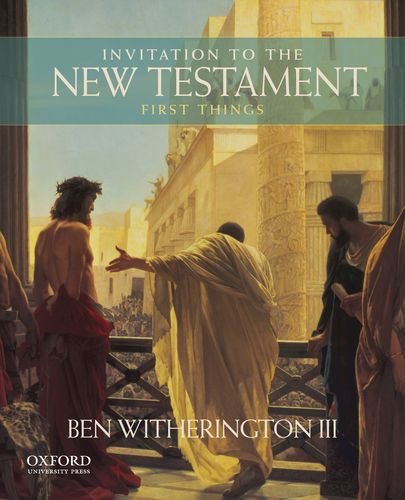by Ben Witherington III
★★★★★
This is a beautiful, full-color university text, complete with Further Reading and Study Questions at the end of each section. It’s very well written in Witherington’s usual fascinating prose, though I did uncover a few editing errors.
The book does a very good job of immersing you into the culture of the first century. Praying for daily bread was a normal prayer for most ancients. You’ll get to know the Judaizers well, whom Witherington presents as subversive competitors to Christianity. To an important extent, you’ll need to be open to the possibility of miracles in order to truly understand the writings.
Be aware that you will receive a biased view of the topic. For example, Witherington argues strongly for one of his pet conclusions: that the author and the Beloved Disciple of the Gospel of John is the man Lazarus, who was raised from the dead. He also is a proponent of early (pre-war) writings in nearly all cases, and argues that every book in the Bible was written before the turn of the century. His trust in the church fathers’ testimony and traditional authorship (such as Peter as the author of 1st Peter) flavors his interpretation. Witherington considers none of the New Testament pseudonymous, arguing that it may have been composed by as small a group as these 11 men: Mark, Matthew, Luke, the Beloved Disciple, John of Patmos, Paul, Peter, James, Jude, Apollos, and the compiler of 2 Peter.
This emphasis is both good and bad: I certainly prefer that a scholar boldly present his own conclusions, especially when they are as well-argued as in this book, but a university text is also expected to present other scholarly opinion, so balance is key. I wouldn’t want this to be the only book you read about the New Testament, but I wouldn’t want you to miss it, either!
One topic where I did feel the treatment was too imbalanced was Witherington’s introduction to Paul. For example, he submits the controversial hymn in 1 Corinthians as evidence of Paul’s high Christology. While Witherington does not emphasize the contested epistles as much as he does the agreed-upon authentic writings of Paul, he does at times seem to lean on the atmosphere of those letters, and thus betrays his conservative bent. The end result is that this portion of the book comes off more as an evangelical work than a scholarly one.
However, when Witherington begins to discuss each epistle individually, he does a superb job. Absolutely superb. With an emphasis on rhetorical style, he presents his case for authorship and dating, and fits the texts together like a jigsaw puzzle.
Regarding the Gospels, Witherington displays an odd lack of emphasis on the passion story. That suits me fine; I just found it odd. His treatment of the Gospels focuses more on the teachings of Jesus than on Jesus’ accomplishments.
All in all, though I’ve presented a few negatives, I have no qualms about ranking this textbook as one of the best religious works of 2013. If Ben Witherington writes it, you should read it.
One final note: If you don’t buy the book, at least sneak into a university bookstore and check out the discussion of the Synoptic Problem in the appendix …with its fascinating color visual of duplicate verses.

